![]()
*Frequently
Updated![]()

Riesling
Uber Alles! ©
Can New
Designations Revitalize German Wines?
©
Michael Vaughan 2001
Wine Access June/July 2001 Issue
Michael
Vaughan is the wine & spirits columnist for the National Post and
publisher of Vintage Assessments.
At one time the mere mention of
the word Riesling and Germany were synonymous. Fact is, you couldn’t
dine out without finding a little Blue Nun on the wine list.
Unfortunately, wine drinking trends haven’t been kind to Germany - the
wines have taken a pounding that brings World War II to mind. While the
huge migration to reds was important, the key factor was the sheer
multitude of German place names and styles that stymied consumers. Added
to this is the strong association with sweetness – anything with
residual sugar was unfashionable.
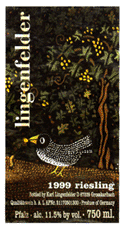
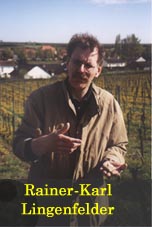 Fortunately,
things are changing rapidly. First, the American market, which is a trend
bellwether, saw German wine imports rise by 23 percent last year - the
greatest increase with the exception of Australia (up 38 percent). While
the strong dollar has influenced this gain, it’s becoming increasingly
evident that German Riesling is once again becoming fashionable, albeit in
a drier style. This is confirmed by the most recent 20001 stats showing
imports are up 26.2 percent in the US and 17.6 percent in Canada.
Fortunately,
things are changing rapidly. First, the American market, which is a trend
bellwether, saw German wine imports rise by 23 percent last year - the
greatest increase with the exception of Australia (up 38 percent). While
the strong dollar has influenced this gain, it’s becoming increasingly
evident that German Riesling is once again becoming fashionable, albeit in
a drier style. This is confirmed by the most recent 20001 stats showing
imports are up 26.2 percent in the US and 17.6 percent in Canada.
Perhaps the best example of these
newer styled wines is Lingenfelder
1999 “Bird Label” Riesling a well-priced QbA Halbtrocken
("half dry") from the Pfalz. The irrepressible owner Rainer-Karl Lingenfelder website markets his wares as the “Dawning
of the Age of PostChardonnism.” He turned to Randall Grahm of Bonny
Doon's label designer for packaging of this lively, just-off dry, new age
Riesling. And while the Bird been a smash success, the fact that he (like
so many other small wineries) only has a limited quantity for sale means
that the real German revival rests on the other producers matching his
success.
A
New Classification for Dry Wines
Indeed, that is the challenge,
because at one time, these drier styles were the bane of tastings. My
induction at the German Wine Academy in 1997, for instance, saw a
cavalcade of thin, tart, fruitless Rieslings. Fortunately, today’s wines
have changed significantly. Indeed, the push to simplify matters for the
consumer has resulted in two totally new classifications – “Classic”
and “Selection” - being
introduced for the year 2000. Labels have been simplified and need only
indicate the vintage, grape variety (only one grape is allowed), region
(in the case of Classic) and vineyard (only in the case of Selection)
along with the producer’s name.
This is basically designed to
eliminate the huge number of vineyard-designated Trocken and Halbtrocken
wines that are in the market – indeed, these terms are not permitted
when the new terms are used. One would like to think that the
“Classic” designation is a replacement for the latter. Indeed, the
wine must have a minimum alcohol of 12% (11.5% for the Mosel-Saar-Ruwer)
and be “harmoniously dry.” And therein lies a difficulty, because
while there is a maximum residual sugar permissible of 1.5%, there
is no minimum meaning that the consumer will not know what style is
being purchased. Indeed, a Halbtrocken wine may actually have higher sugar
levels – up to 18 grams. According to statistics about 22% of all German
wines fit into this category, while almost half is of the traditional
style with sugar levels of 18 to 45 grams per litre (2 to 5 percent
residual sweetness).
By contrast, the “Selection”
wines come from riper grapes requiring a higher minimum level of natural
potential alcohol 12.2% at harvest and a lower threshold of sweetness .9%
which is the maximum for a “Trocken” (or up to 1.2% for Riesling). In
addition, the vines have a maximum yield of 60 hl/ha and must be hand
harvested. Unlike the Classic designation, Selection wines will be subject
to a sensory examination. Trocken wines have been one of the fastest
growing categories accounting for 28% of total production.
While I would like to think that
this would be a good solution for German wines (to date 120 producers have
signed up), I certainly have my reservations. First, to many consumers the
word “classic” seems to carry with it a sense of superiority over
“selection.” Worse yet, some might think that “classic” is the
older, sweeter, more traditional style of German wine. Unfortunately, the
recently organized tasting of Classics tasting found many of the newly
launched wines to be decidedly tart, dry and thin. The key problem here is
that the 2000 vintage was far from stellar. It was fraught with
difficulties and lots of rainfall making me skeptical that this
introductory release of Classics will prove popular in the North American
market.
While it appears the Germans
themselves have gone wild about these extremely dry wines, I don’t think
this style is necessarily appropriate for the North American market where
some residual sugar is often required to balance the high acid levels
found in many wines. Indeed, these new styled “drier” Rieslings are
coming out of the woodwork from riper grapes (meaning better mouthfeel and
more fruit forward flavours) from vineyards all over the world. It seems
that only the quality-driven German houses producing better wines will be
able to withstand the competition in the export market. And these are
precisely the firms that really don’t need to rely on simplistic
“Classic – Selection” designation to sell their wines. In fact, many
respectable producers like Lingenfelder aren’t even bothering putting
the Trocken and Halbtrocken on the label. This group isn’t about to join
the band, which consists of many producers who have yet to score
internationally.
Moreover, knowledgeable buyers
will still want to have their delicious Spatlese and Auslese wines with
all their traditional sweetness. At the lower end of the spectrum, the
economical, sweeter, low –alcohol, high volume wines will also maintain
their much reduced market share – “live-frog’s-milk” will not
disappear. The big growth will indeed be in the drier area, but not in
necessarily (at least not yet) in the new “Classic – Selection”
class but in the higher quality, more expensive, winery-driven range.
Producers like Zenzen, Johann Geil, Marbé-Sans, Vollmer, Selbach, Georg
Bruer, Franz Künstler, etc. will be the key players because they can
truly compete internationally.
The
2000 Vintage
 As for the problems relating to
the challenging 2000 vintage, let me quote Louis
Konstantin Guntrum’s sardonic notes: Winter
too mild. Spring late and much too hot. Summer fine till July's 150 litres
of rain per square metre - 3 times the average - going into rains again at
most inappropriate times - in the ripening month of September and even at
harvesting time October - seems new trend since last five years - insane -
basic changes? Dry an autumn could have made many Trockenbeerenauslese and
healthy Eisweine - drowned in rain and rot.
As for the problems relating to
the challenging 2000 vintage, let me quote Louis
Konstantin Guntrum’s sardonic notes: Winter
too mild. Spring late and much too hot. Summer fine till July's 150 litres
of rain per square metre - 3 times the average - going into rains again at
most inappropriate times - in the ripening month of September and even at
harvesting time October - seems new trend since last five years - insane -
basic changes? Dry an autumn could have made many Trockenbeerenauslese and
healthy Eisweine - drowned in rain and rot.
I had the privilege of doing a
vineyard tasting with the master himself while climbing the steep
Niersteiner Hölle vineyard overlooking his winery beside the Rhine River.
There were four tasting stations, which were terrific stops but, quite
frankly, somewhat challenging for someone who is used to the tranquility
of the lab. Guntrum’s biggest success has been with their” Royal
Blue Bottle” Riesling which has 8.5% alcohol and 37.4 grams of
residual sugar. They also have a golden yellow bottled Silvaner Spatlese
and a red bottled Schreube Kabinett.
What was particularly interesting was the presentation of the
premium “Guntrum Classic” wines. Of course, these “erstes gewächs”
or “single vineyard” wines that have nothing to do with new
appellation which perhaps typifies the German dilemma of so many producers
all moving in different directions.
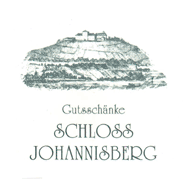 On a positive note, I want to be
absolutely clear that not all the Rieslings from the 2000 vintage are
disasters. Indeed, a vintage chart or even a simple synopsis as presented
above is only the grossest of generalizations. Certainly for 2000, the
specific vineyard site and cluster reduction by a green harvest are key
factors. Regions with steeper slopes and lower yielding vines had the best
chance of making decent wine. Recent visits to several, quality-minded
estates bore this out. At Scholss Johannisberger, for instance,
their 2000
Grülack Spätlese Trocken
Fassprobe Riesling with
its fine, fresh, gently honeyed, grapefruit flavours was a testimonial to
excellent steep slope drainage in a very wet year.
On a positive note, I want to be
absolutely clear that not all the Rieslings from the 2000 vintage are
disasters. Indeed, a vintage chart or even a simple synopsis as presented
above is only the grossest of generalizations. Certainly for 2000, the
specific vineyard site and cluster reduction by a green harvest are key
factors. Regions with steeper slopes and lower yielding vines had the best
chance of making decent wine. Recent visits to several, quality-minded
estates bore this out. At Scholss Johannisberger, for instance,
their 2000
Grülack Spätlese Trocken
Fassprobe Riesling with
its fine, fresh, gently honeyed, grapefruit flavours was a testimonial to
excellent steep slope drainage in a very wet year.
As for other vintages currently on
the market - the 1999 a good, albeit very prolific vintage produced many
decent wines which are showing nicely. From the Rheingau is Franz Künstler1999 Hochheimer Hölle Riesling
Auslese Trocken, which is quite stunning with its bright,
lively and yet elegant, fresh, pear purée flavours. Unlike some
producers, all the fruit flavours are totally natural - no sweet reserve
is used to push up fruit. Gunter Künstler
and Cellar master Frank Fischer
have done an excellent job in producing 3,000 bottles of this Auslese. In
fact, the ’99 Beerenauslese (untasted) was the only German wine to
appear in Decanter’s recent list of fifty Rising
Stars of Fine Wine.
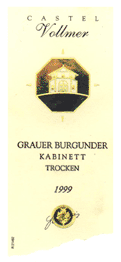 One of the best value wines tasted
on a recent trip was Heinrich
Vollmer’s 1999
Grauer Burgunder Ellerstadter Kirchenstüch Kabinett Trocken.
I was so excited by its delicious tangerine-pear purée flavours that I
actually brought a bottle back with me and sampled it in the LCBO lab with
Vintages/Classics buyers. Unfortunately nothing came of this exercise, nor
has the agent been successful with an attempt to get it listed! Apparently
it was too late for this year!
One of the best value wines tasted
on a recent trip was Heinrich
Vollmer’s 1999
Grauer Burgunder Ellerstadter Kirchenstüch Kabinett Trocken.
I was so excited by its delicious tangerine-pear purée flavours that I
actually brought a bottle back with me and sampled it in the LCBO lab with
Vintages/Classics buyers. Unfortunately nothing came of this exercise, nor
has the agent been successful with an attempt to get it listed! Apparently
it was too late for this year!
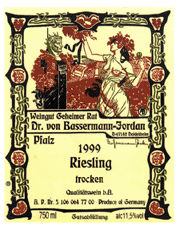 Unfortunately, the finer older
vintages are disappearing quickly. Vollmer’s well-structured,
raspberry-black cherry flavoured, barrel aged 1998
Spätburgunder Ellerstadter Kirchenstüch QbA Trocken is
definitely worth a detour (it recently won a Silver Medal) if you can find
it. Of course, there are many gems from 1997, which although perhaps more
challenging, produced wines of great concentration due to abnormally low
yields.
Unfortunately, the finer older
vintages are disappearing quickly. Vollmer’s well-structured,
raspberry-black cherry flavoured, barrel aged 1998
Spätburgunder Ellerstadter Kirchenstüch QbA Trocken is
definitely worth a detour (it recently won a Silver Medal) if you can find
it. Of course, there are many gems from 1997, which although perhaps more
challenging, produced wines of great concentration due to abnormally low
yields.
As German wines are becoming increasingly food-friendly, the current growth of premium drier German wines should continue. What is significant is that crisp, bright wines like Dr. von Bassermann-Jordan 1999 Riesling Trocken from the Pfalz is now being featured in many upscale New York City restaurants by the glass. It’s demonstrative of where things are going in North America.
Copyright Food & Beverage Testing Institute of Canada 2001
Toronto, Ontario
mbv@total.net